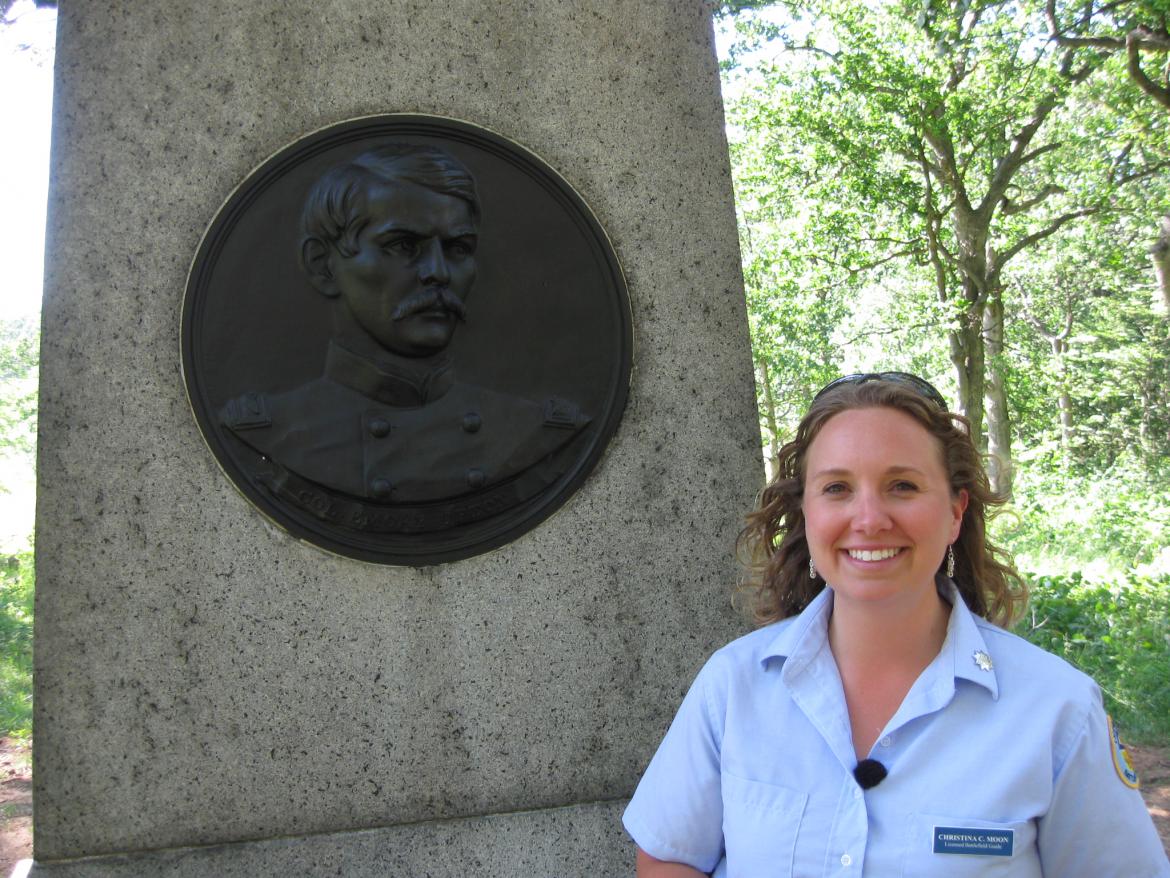West Point's Class of 1861 Part 2 With Licensed Battlefield Guide Christina Moon
Gettysburg Licensed Battlefield Guide Christina Moon is the host for our series on the United States Military Academy's Class of 1861. Christina is standing on the north slope of Little Round top by the monument to the 121st New York Infantry Regiment. On the monument is a bronze bas-relief of Colonel Emory Upton. This image was taken facing north at approximately 5:00 PM on Thursday June 2, 2011
Gettysburg Licensed Battlefield Guide Christina Moon is our host for a series on members of the West Point Class of 1861 who fought at the Battle of Gettysburg. With the coming of the Civil War, the academy had two classes graduating that year because the original class of 1862 petitioned to graduate a year early. So the original class of 1861 graduated in May, 1861. The original class of 1862 graduated in June, 1861. We will refer to them throughout the series as the May and June classes. Christina has been a Licensed Battlefield Guide since 2008.
In the first West Point Class of 1861 post, Gettysburg Licensed Battlefield Guide Christina Moon discusses the life of May, 1861 graduate Adelbert Ames who commanded a brigade and a division in the Eleventh Corps. At Gettysburg, Ames' Brigade had 1337 engaged and suffered 778 casualties (68 killed, 366 wounded, and 344 captured) for a total percentage loss of 58.2%.
In today's West Point Class of 1861 post, Gettysburg Licensed Battlefield Guide Christina Moon presents the life of Colonel Emory Upton who commanded the 121st New York Infantry Regiment at Gettysburg.
To email Licensed Battlefield Guide Christina Moon, please click here to reveal her address.

This map shows the location of where our West Point Class of 1861 at Gettysburg videos were produced. Videos #1-#4 were shown in our first post. Videos #5-#7 were taken at the 121st New York Monument on the north slope of Little Round Top. This map was created facing north at approximately 7:00 AM on Saturday, June 4, 2011.

Emory Upton (1839-1881) graduated eighth in the forty-five member class of May 6, 1861. He commissioned a second lieutenant in the United States Army Artillery. This view was circa 1861 and is courtesy of Christina Moon.

The monument to the 121st New York Infantry Regiment is on the north slope of Little Round Top. Sykes Avenue runs from right to left (south to north) in the background. This view was taken facing northeast at approximately 5:00 PM on Thursday June 2, 2011.
Moon001In Video #5 Gettysburg Licensed Battlefield Guide Christina Moon is standing on Little Round Top by the monument to Emory Upton. She presents some information on Emory Upton before the Civil War. This view was taken facing north at approximately 5:00 PM on Thursday June 2, 2011.

Licensed Battlefield Guide Christina Moon is standing by the monument to the 121st New York Infantry Regiment. The monument was dedicated on October 10, 1889, or approximately eight years after the death of Emory Upton. The monument to the 98th Pennsylvania Infantry Regiment is in the left background. This image was taken facing northwest at approximately 5:00 PM on Thursday June 2, 2011.
Moon02In Video #6 Christina Moon is standing on Little Round Top by the monument to the 121st New York Infantry Regiment. She describes the Civil War career of Emory Upton, including his unit's actions at Gettysburg. This view was taken facing northwest to northeast at approximately 5:00 PM on Thursday June 2, 2011.

A closer view of the bas-relief portrait of Emory Upton on the monument to the 121st New York Infantry Regiment. This image was taken facing west at approximately 5:00 PM on Thursday June 2, 2011.
Moon03In Video #7 Christina Moon is standing on the north slope of Little Round Top. She describes Emory Upton's post war career and his death. This view was taken facing west at approximately 5:00 PM on Thursday June 2, 2011.

In the introduction to the Life and Letters of Emory Upton, Major General James H. Wilson wrote, "Upton was as good an artillery officer as could be found in any country, the equal of any cavalry commander of his day, and, all things considered, was the best commander of a division of infantry in either the Union or the rebel army. ... He was incontestably the best tactician of either army, and this is true whether tested by battle or by the evolutions of the drill field and parade. In view of his success of all arms of the service, it is not too much to add that he could scarcely have failed as a corps or army commander had it been his good fortune to be called to such rank. ... No one can read the story of his brilliant career without concluding that he had a real genius for war, together with all the theoretical and practical knowledge which any one could acquire in regard to it. Up to the time when he was disabled by the disease which caused his death he was, all things considered, the most accomplished soldier in our service. His life was pure and upright, his bearing chivalric and commanding, his conduct modest and unassuming, and his character absolutely without blemish. History cannot furnish a brighter example of unselfish patriotism, or ambition unsullied by an ignoble thought or an unworthy deed. He was a credit to the State and family which gave him birth, to the military academy which educated him, and to the army in which he served. So long as the Union has such soldiers as he to defend it, it will be perpetual." This image was taken circa 1865 and is courtesy of the Library of Congress.
To see other posts by Gettysburg Licensed Battlefield Guides, click here.






